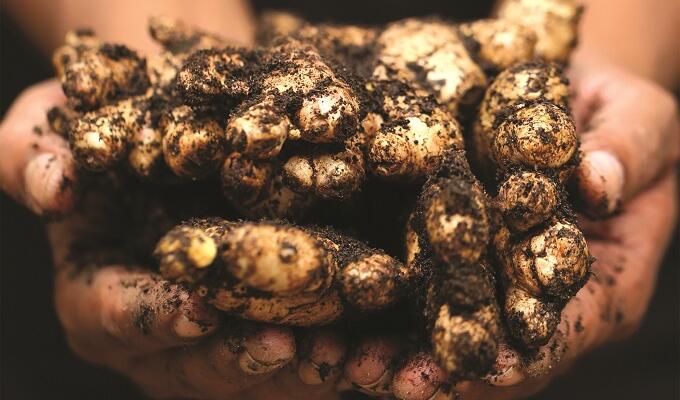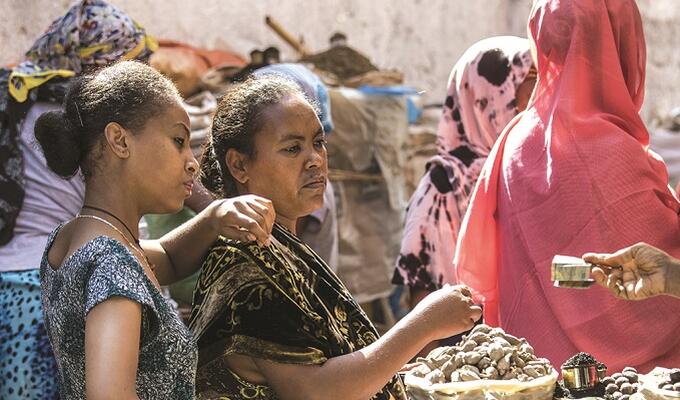

Spicing up south-south trade
Some 80,000 farmers in Ethiopia depend on ginger cultivation. A 2011 outbreak of bacterial wilt, a plant disease, reduced ginger yields nearly to zero, putting their livelihoods at grave risk.
Four years later, as the International Trade Centre (ITC) Supporting Indian Trade and Investment for Africa (SITA) project started its implementation phase, spices were being looked at as a promising sector for promoting increased trade and investment between Ethiopia and India.
In meetings with ITC and other project partners, Ethiopian officials argued any strategy for improving farmers’ livelihoods through spice exports would make little sense unless the ginger sector was rehabilitated. During one session, Ethiopian colleagues demanded to know how the project would help ginger farmers. This priority, though emphatically voiced by the project’s Ethiopian counterparts, sat uneasily with SITA’s post-farm gate focus.
The SITA team weighed the risks. On one hand, tackling plant disease went beyond ITC core competences. On the other, the disease was in effect a supply-side constraint on export capacity and the payoff, in terms of potential livelihood improvement, was enormous. Moreover, given ginger’s widespread cultivation in India, where farmers also cope with bacterial wilt, the situation tied neatly into SITA’s underlying rationale of leveraging Indian investment and expertise to boost exports and job creation in eastern Africa.
The project team decided to undertake a survey of affected farms in Ethiopia’s Oromia region to evaluate the extent of the problem while consulting Ethiopian stakeholders, government and local research agencies across the region about solutions SITA could offer. An Indian subject matter expert was identified: Dr. C.K. George, the former executive director of the Spices Board of India. Following desk research, ginger experts and ITC team members went on field visits, meeting with dozens of farmers and five processors in the wilt-affected region. Incomes and morale had fallen drastically and farmers were unsure of what to blame for the destruction of their crops.
A compelling case emerged for a pilot intervention. The options reviewed ranged from leaving the land fallow to quarantining affected areas in a manner worthy of a science-fiction movie. Ultimately, what seemed most viable was what George described as ‘a tailored package of practices’ that had helped India learn to live with the disease. India has developed practical solutions that may not eradicate the disease completely but allows farmers to manage good yields in spite of it. This was the kind of jugaad solution – a colloquial Hindi term referring to a low-cost innovative hack to solve a problem – the SITA team had been seeking.
Given the unusual risks associated with the pilot initiative, a proposal was prepared immediately for approval by SITA’s funder, the United Kingdom’s Department for International Development, as well as ITC management. Once approval was secured the team reassessed the feasibility of replicating Indian bacterial wilt management practices in Ethiopia. A large commercial farmer agreed to try to the package of practices and set up a demonstrator farm to try new planting, ploughing and fungicide use techniques.
Procedures such as ‘soil solarization’ – mulching soil and then leaving it in the sun under clear plastic during the hot season – were also practised in an attempt to use heat to kill pests. The idea was that if the demonstration succeeded, smaller farmers could replicate the improvements.
Ethiopian government and research institutions were invited to be part of the process. News of the pilot programme started to spread. The Ethiopian Coffee and Tea Development and Marketing Authority (ECTDMA), Ethiopia’s nodal agency for spices, contacted SITA’s national coordinator in Ethiopia to express appreciation for the initiative and offered to convene a national workshop to develop a work-plan for ginger rehabilitation. This represented a significant step forward for ginger farmers, who had been suffering for lack of a coherent plan to tackle the bacterial wilt problem.
The workshop was held in April 2016, hosted jointly by ECTDMA and ITC. The gathering brought together a wide cross-section of stakeholders from Ethiopia’s spices industry, including the state minister for agriculture. It led to the development of a 30-month ginger rehabilitation plan funded entirely through national resources. In parallel, with ginger now firmly on the policy radar, other donors pooled resources to invest in revising the sector. Consequently, numerous workshops were organized across the country and additional approaches were tested, such as intercropping with turmeric and planting lab-grown ginger. Farmers described the concerted efforts to tackle bacterial wilt as a ray of hope they had not seen for years.
Meanwhile, the ITC team closely monitored the ginger project. The demonstration farm sent crop pictures fortnightly to George to seek his advice. Despite the interventions and the surveillance, however, the crop due for harvest in December failed. The package of practices that worked in India did not produce successful results in Ethiopia.
Yet when the SITA team carried out an objective assessment of the interventions, it became clear that farmers in the country’s Southern Nations, Nationalities, and Peoples’ Region were receiving far more support than before the pilot programme had started. Though it is too soon to know whether these alternative approaches to combating ginger wilt will fare any better, results should become visible in 2018.
From SITA’s point of view, the team managed to generate goodwill and to expand its clientele. The SITA team will thus continue to allocate a part of its resources to promising high-risk, high-impact pilots. Such investments will happen within a clear framework: there must be a compelling case for intervention and both public and private-sector partners must be committed, with ‘skin in the game,’ to seeing the initiative through. One such example is the recent introduction of new hybrid chili varieties in Rwanda with an eye to exporting to India and other markets.
Development assistance provides a unique opportunity to invest in projects where market risks might dissuade private investors even though the potential social and economic returns are high. When such projects merit strong support, fear of failure should not discourage us from pursuing them. At ITC we are committed to doing so. While we may not always succeed, we learn from our disappointments.



